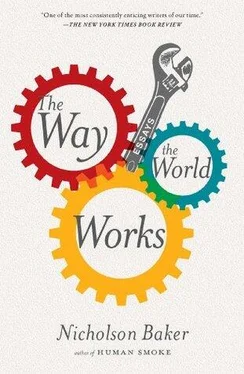The awards are deserved, but they don’t convey how consistently good his magazine is. Remember, it’s a weekly. Every Monday it’s in the mail, or in the newsstand, or on a little flat screen, reassuring a million subscribers that things are still pretty much under control in the transatlantic world of letters. There are always at least a few funny cartoons, and one absorbing piece about something or another, and perhaps a brilliantly dismissive movie review by Anthony Lane, who sharpened his pencil at the Independent before Tina Brown, Remnick’s predecessor, lured him away. I confess I don’t read it all — few can — but let me just say it right now: The New Yorker is one of the three great contributions the United States has made to world civilization. The other two are, of course, Some Like It Hot and the iPhone. Maybe you have your own list. But it’s likely The New Yorker will be on it somewhere, because the magazine has been sharp and witty since the 1920s, angling unexpected adjectives in place with winning exactitude.
Its tone, from the outset, was, as John Updike described it in an onstage interview with Remnick, “big-town folksy.” E. B. White was one of the early sources of the style — along with James Thurber and Joseph Mitchell, and an alcoholic named John McNulty, who wrote stories about regulars at a bar on Third Avenue. Later there was Maeve Brennan, from Ireland, who wrote beautiful unfurling paragraphs about living in cheap hotels in the city, using as her byline “The Long-Winded Lady.” Brennan was evidently a little crazy toward the end, as writers tend to be, but in her “Talk of the Town” prose she is extremely sane and full of kind attentiveness.
And there were the cartoonists — Peter Arno, who liked drawing high-breasted showgirls, and Saul Steinberg, who made surreal black-and-white rainbows, and William Steig, whose trembly pencil seemed never to want to leave the paper, and George Booth, master of quizzically frowning brindleeyed dogs. There were storytellers, too — J. D. Salinger, John Cheever, Updike, William Trevor, Alice Munro, and John O’Hara, who in his prime could tell a tight, bitter tale of private woe in 1,800 words. A magazine that has been around for this long pulls its own history behind it like a battered Brio train. At the front is David Remnick, gently drawing it forward, helping it over the next little blond wooden hill, hoping that the shiny domelike magnets don’t detach.
I was in the New Yorker offices, on the twentieth glass-sheathed floor of the Condé Nast building in Times Square, one Friday in April. The week’s issue had just closed, and the place was quiet. People stared at their screens, catching up with all the things they had put off during the recent editorial flurry. Remnick was having his picture taken, so I said hello to Pam McCarthy, the magazine’s deputy editor, whose office is next to Remnick’s. What is he like to work with? I asked her.
“He’s easygoing, and he’s not,” said McCarthy. “He likes to keep his finger on every detail. He really pushes until it’s right. He’s a great floorwalker. He circles the floor several times a day and talks to people.”
Just then Remnick came in with Alexa Cassanos, the director of publicity, and the four of us talked about earphones and earplugs. “In Maine why would you need earplugs?” Remnick asked me. (I live in Maine.) “When I’m out of the city,” he continued, “I’m up till four in the morning because it’s so damned quiet. I think somebody’s going to jump in and strangle me. It’s not relaxing.”
We walked a few blocks to a seafood restaurant, Esca, on Forty-third Street, where Remnick goes once in a while. Mark Singer, one of the magazine’s best-known writers of profiles, wrote a piece on Esca’s owner, Dave Pasternack, who does his own fishing around Long Island and knows how to cut mahi-mahi into raw tidbits.
Pasternack himself came by the table soon after we’d sat down and told us that he’d opened up a new business — a seafood concession in center field of the Mets’ baseball stadium, where he sells crabcakes, fish sandwiches, lobster rolls, and chowders. Jeff Wilpon, the general manager of the Mets, lost a lot of money several years ago to Bernie Madoff’s Ponzi scheme, but, according to Pasternack, Wilpon was upbeat about his life. “I was at a party the other day,” Pasternack said, “and I go, ‘How’re you doing?’ Wilpon goes, ‘I was rich and miserable and now I’m poor and happy.’”
“Are you sure about the latter?” asked Remnick.
Suddenly I had a strange and not unpleasant sensation. I’d entered the printed pages of The New Yorker; I was physically inhabiting a Mark Singer profile, as edited by David Remnick.
Pasternack said, of Wilpon, “This is a guy who came to me to ask if I wanted to do a concession. I said, ‘I’ll make a couple of things for you.’ I bring a lobster roll down — beautiful lobster roll, toasted bun, nice and buttery the way it’s supposed to be. He looks at me and he says, ‘I don’t like toast.’ All I could think about is: when you’re born they give you toast, and on your deathbed they give you toast. Who in this world doesn’t like toast? When you’re sick they give you toast!”
“I get cartoons about toast every week,” said Remnick.
“Yeah?” said Pasternack.
“I got a cartoon,” said Remnick, “it was a toaster the size of the restaurant.” He turned to me. “Do you waste your time watching baseball?”
I said no, not really, I’m out of it.
Remnick said, “I’m sure that when I’m on my deathbed. .”
“You’re going to have toast,” said Pasternack, with finality. Then he went away to fillet more fish.
I asked Remnick what his dining room was like when he was a kid. “Lots of mirrors,” he said. “We didn’t eat in the dining room.” He grew up in Hillsdale, New Jersey—“Springsteen Jersey, without the shore”—and his mother got multiple sclerosis when he was six. Some years later, his father, a dentist, became ill with Parkinson’s disease. “To be a Parkinsonian dentist is like a Buster Keaton movie,” Remnick told me. “It’s funny unless you’re living it.” In high school he edited the school paper, The Smoke Signal, writing articles for it under several pseudonyms. He wasn’t a devoted New Yorker reader then. “ Guitar Player magazine meant more to me in high school than The New Yorker, ” he said. “There were no chord diagrams in The New Yorker .”
He studied comparative literature at Princeton and took a class with the New Yorker writer John McPhee, who taught him that you have to be willing to seem stupid when you interview people. He spent a semester in Japan, teaching English and feeling lonely. He also went to Paris, where he wore a Leon Russell T-shirt and nine-dollar Converse sneakers and made money singing Bob Dylan songs in the Metro. His Princeton classmates were all getting jobs as investment bankers; he got a job at the Washington Post, as the night crime reporter. He covered boxing for a while, and then, as he limbered up, he interviewed celebrities in their hotel rooms. He was good, something of a prodigy in fact — a natural reporter, nimble and prompt with copy.
The Washington Post sent him to Russia in 1988, with his new wife, where he covered, with astonishing fecundity, every phase of the disintegration of the Soviet empire. He wrote somewhere between three hundred and four hundred stories a year, watching and learning from Bill Keller, the fast-fingered Russian correspondent for the New York Times, later its editor-in-chief. Framed in Remnick’s office is the front page of the Washington Post for August 24, 1991, which has two Remnick stories. The top one begins: “Communist rule collapsed tonight in the Soviet Union after seven decades as President Mikhail Gorbachev resigned as Communist Party general secretary and ordered the government to seize all party property.”
Читать дальше












